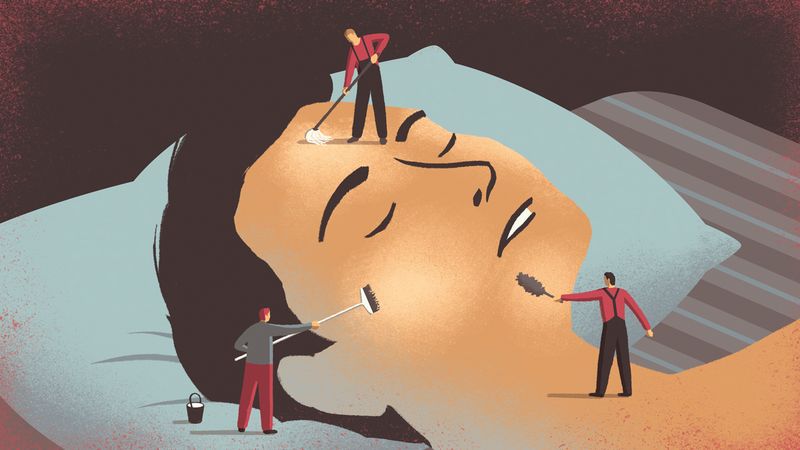THE JOURNAL

Illustration by Mr Davide Bonazzi
Sleep expert Mr Nick Littlehales stumbled into his current career after writing to Sir Alex Ferguson, then the manager of Manchester United football club, to ask what kind of approach his players had to maximising the effects of their nightly shut-eye. It turned out that they didn’t – a circumstance that ultimately led Mr Littlehales, then working as sales and marketing director for sleepcare brand Slumberland, to rebrand himself as the world’s first sports sleep coach. In the process of working with Manchester United and other football teams, as well as elite athletes from disciplines as diverse as cycling, sailing, BMX and bobsleigh, Mr Littlehales perfected a sleep treatment program he calls “R90”, referring to the 90-minute cycles of which all human sleep is composed. According to this system, the principles of which Mr Littlehales outlines in his new book Sleep, what we should be looking for is not a good night’s sleep of eight hours (the average figure usually thrown about by statisticians) but a weekly allocation of 35 cycles, or five cycles per night on average.
Thinking of sleep in this way, says Mr Littlehales, allows us much more flexibility when it comes to getting enough rest, allowing for the inevitable nights when family and work commitments keep us up longer than we might want, as well as helping us to get the most out of it. Of course, the entire plan is a lot more complicated than that – in the course of Sleep, Mr Littlehales outlines various other means by which we can sleep (and wake) better, from clearing clutter and distraction from our sleeping spaces, to spending more time getting ready for bed and planning sleep cycles to match our own personal circadian rhythms. As a taster, we offer the three following tips for better sleep, all drawn from the book. Some of them might surprise you.

Discover your personal "cronotype"
Part of the problem with the eight-hour sleep rule, says Mr Littlehales, is that it doesn’t account for the fact that everyone is different, and is naturally inclined to need different amounts of sleep at different times. “Your chronotype describes your sleeping characteristic – whether you’re a morning or an evening person,” says Mr Littlehales. “Why is it important to know your chronotype? If we were left to our own devices, to get up and go to sleep whenever we wanted… it wouldn’t matter hugely. But strangely enough, working cultures have yet to develop with this in mind. Whether you’re an ‘AMer’ or a ‘PMer’, you still have to get to work for 9am.” Once you’ve worked out your Chronotype – Mr Littlehales recommends an online evaluation run by the University of Munich – you’ll be in a better place to offset its quirks. PMers, for example, should avoid lie-ins at the weekend (which will exacerbate their tendency to sleep later in the evening). AMers, meanwhile, can plan their day to make sure all the important stuff gets done in the morning, as they’ll be more sluggish come afternoon.

Breathe through your nose
“Getting our breathing right while we sleep is vital if we want to transition undisturbed through our sleep cycles,” says Mr Littlehales. And by “right”, he means through the nose, rather than the mouth – the latter option, he says, makes snoring and sleep apnoea (where the sleeper stops breathing momentarily and wakes themselves up) far more likely. How do you even know if you’re doing it? “If you wake up with a dry mouth and almost always take a drink of water to bed with you, it suggests you breathe through your mouth when you sleep,” says Mr Littlehales. As a remedy, he suggests using Breathe Right nasal strips, as well as, for the seriously dedicated, medical tape or SleepQ+ gel to seal the mouth off overnight.

Ditch the pillows
A bedding and mattress expert, who has developed his own line of “sleep kits” for the use of travelling athletes and sportsmen, Mr Littlehales spends some time in his book explaining how to make sure your mattress supports you in a perfect sleeping posture. The biggest surprise here, though, is that pillows, though comforting, tend to throw the alignment of your neck and spine off balance, even in a perfect mattress. “A pillow is an inner sole for a mattress that does not fit,” he says. “We use them to fill that gap between the head and the surface when the mattress is too firm, and when the mattress is too soft, they push our head even further out of alignment and can cause postural problems. If you are sleeping on two or even more pillows, then you’ve either got a very firm mattress or you’re storing up trouble for yourself.” In most cases, he says, particularly if you have a mattress that is not too firm, “a single shallow pillow for comfort will do you just fine”.